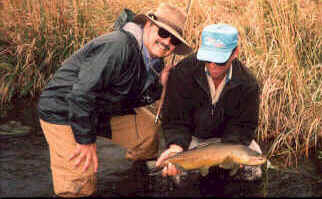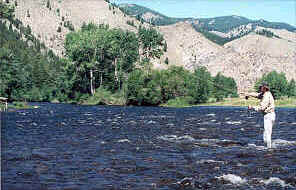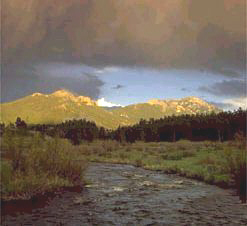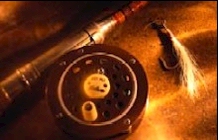The Big Hole River comes to
life in the Beaverhead Mountains south of Jackson,
Montana, as the outlet of Skinner Lake, elevation 7,340.
Throughout the 155.6 miles it flows, the Big Hole takes
on many faces. From its beginning as a small mountain
stream, the Big Hole flows north to Wisdom, where it
gains strength by joining with the North Fork and flows
northeasterly for about 25 miles.
This brut was
caught on the lower section of the Big Hole near
Melrose.
 |
It then flows 27 miles
eastward past Wise River and Divide, gaining more volume
from several creeks, as well as Wise River itself. At
Divide the river changes course to the south and is
paralleled by interstate 15 for 17 miles. Then, at Glen
the Big Hole heads southeast for its remaining 25 miles
to the point where it joins the Beaverhead, and forms
the Jefferson River, near Twin Bridges, Montana, at an
elevation of 4,600 feet. Much of the Big Hole's water
comes from the Beaverhead, Pioneer and Anaconda
Mountains.
Summer time
fly fishing on the Big Hole River.
 |
With the drought this part of Montana
(as well as much of the western U.S.) has been
experiencing over the last several years, water flows on
this river have been depressed, and is especially
noticeable during the late summer and fall months.
Fishing on the Big Hole River has always been popular.
This river is one of Montana's best, with a diversity
that's hard to match. The Big Hole hosts rainbow, brown,
cutthroat and brook trout. Rocky Mountain whitefish are
also present, as well as the last fluvial
(river-dwelling) population of grayling in the United
States, outside of Alaska, of course. Much of the land
bordering the Big Hole River is privately owned, so
floating the river will let you cover the greatest
amount of water.
The Big Hole is fishable from its
source down to its confluence with the Beaverhead. This
river takes on many faces throughout its journey; from
mountain stream, to meadow stream, tumbling through a
canyon and then on to a broad slow-moving river
meandering through farmland. The Big Hole has a variety
of water that can be fished using a variety of methods.
The Montana Department of Fish, Wildlife and Parks
manages the Big Hole fisheries in several segments, with
slot limits, gear restrictions, and regulations suited,
they believe, to best manage the fish in each segment.
Evening
fishing abruptly ends, when a storm arrives on the Big
Hole River.
 |
To put the minimum flow figure in perspective, when
the Big Hole was closed to fishing for a few months
starting in August of 1994,the flow was measured at the
Melrose gauge around 130 cfs.
Fishing Season: The Big Hole is a river in
which fishing is very much influenced by the seasons.
Fluctuation in water flow, and consequently high water
temperatures, is the key reason the fishing drops off
and this can be attributed to a variety of reasons . . .
Water flow information is available from the USGS in
Helena (406) 449-5263. The gauging station is located
between Melrose and Glen, and when planning a float trip
down the Big Hole it is a good idea to call first . . .
Records show that the average flow of the Big Hole over
a 64 year period was 1,162 cfs.
Spring: Winters in the Big Hole Valley can be
quite severe. Temperatures are often brutal, dropping
well below zero. When the upper river begins to thaw in
spring, good fishing is not far off. In fact, you can
fish much of the river whenever there is open water.
During early spring the water level on the 'Hole' will
normally be low. Not like summertime lows, but low
nonetheless.
March will see a slight rise in the river, but it
isn't until April and May that there is a significant
increase in volume due to snow melt. Fishing during this
time can be interesting. The upper river and its
tributaries are good places to focus your attention,
while there is ample water to fish them. It is also a
time when you see few anglers on the river.
Spring hatches on the Big Hole start, as in most
western rivers, with midges as soon as there is open
water. If afternoons are particularly warm, trout will
rise to adults, even if there is still ice around the
edges of the stream. Wire pupas such as the Brassie work
well, as do many midge pupa imitations. For the adults
on top, its hard to beat the Griffith's Gnat tied in
size 16 or 18.
Hatches will be in full-swing by late April and May.
The floating angler should pay special attention to the
banks, foam lines and structure, making a point to
anchor or get out and fish these areas thoroughly.
Caddis and mayfly hatches can produce top-water feeding
frenzies that trigger hot action to those who happen to
be on the water when its going on. Nearly any caddis
pattern properly presented this time of year in this
stretch of river is a safe bet.
During a normal year, with normal snow-melt and
runoff, the salmonfly hatch will begin early to
mid-June. Anglers descend upon the Big Hole in masses to
take part in the frenzy. This is the busiest time of
year on the 'Hole,' and the river can become quite
crowded with boats as well as bank anglers. Outfitters
from all over the state guide the Big Hole during the
salmonfly hatch, and, their presence, although legal, is
quite the controversy among local guides. After the
salmonfly hatch, fishing pressure on the 'Hole' drops
dramatically, even though angling is still very good . .
. caddis and mayfly hatches are abundant, and are pretty
much widespread throughout the entire river.
Summer:
June sees a major change in the flow of the river.
Irrigation demand is heavy and, with the watershed
drying up by late June like it has for the past several
years, the flow of the 'Hole' is greatly reduced, on
average, from its peak of around 4,200 cfs at the first
of the month, down to around 1,200 cfs by the end of
June.
Early summer fishing is good though. Caddis are the
predominate hatch, with some smaller stoneflies and
again, a variety of mayflies. It is wise to remember
that there are some real monsters in this river and the
light tippets that produce 'the most' strikes will most
likely fail if you hook a true pig. It's a bit of a
trade-off; light tippet, dry fly - lot of fish or heavy
tippet, big streamer - and maybe a trophy.
It's a tough call sometimes, especially when you snap
a large fish off that rose to your fly. What I like to
do, especially when floating, is to have two rods
rigged, one with a floating line and dry fly, the other
with a big nymph or streamer. That way I can fish the
water more thoroughly and up my odds of hooking Mr. Big.
Fall: Traditionally, fall is my favorite time
on the water. And the Big Hole has been good to me in
the fall. The period of time in fall when night
temperatures have cooled the water down enough to make
fish active again, all the way to ice-up can be a
productive time for monster hunting.
In fall, Baetis mayflies can be
important during hatches, which occur during the warmest
part of the day. A tiny, number 18 or 20 BWO or Black
Baetis can take a surprising number of fish if you find
an area where a good hatch is coming off. Watch along
the banks close to good holding water. Trout move to the
edge of the faster current and sip in the small mayflies
right on the current seam. Takes are often very subtle,
so keep a close watch on your fly and leader.
You can find good Baetis beds along the
entire river system. I prefer to fish the canyon stretch
near Divide when the Baetis are on, and
during the periods when nothing is hatching, I will
bounce a nymph along the bottom through the deeper water
with hopes it will find its way into the mouth of a big
brown.
As the water temperatures cool down below the 40
degree mark, trout will be harder to make contact with
and whitefish hookups will be more frequent.
Winter: At times trout can be taken during
winter months but are usually "incidental catches" by
those fishing for whitefish. There are some monster
whitefish in the Big Hole, and they seem to be very
plentiful. There is an extended whitefish season on the
Big Hole from December 1 to the third Saturday in May
with maggots and/or artificial flies and lures only. Due
to the abundance of these fish, the limit is 100, [at
this writing, always check local regulations.
Although the winters can be cold and river ice can
interfere with fishing for whitefish, there are places
on the stream where conditions let you fish for
whitefish for a good part of the winter season. Catches
by those targeting whitefish are usually high.
Information provided by Frank Amato Publications "River
Journal Series" We greatly appreciate their
information and permission.
|





